Not far beyond the village of Vík, where I had spent the previous night lies the Eldraun lava field. At first it looks like mile after mile of low scrub, green and somewhat bushy. But it is in fact rock. Basalt; borne of lava from the Laki volcanic eruption of 1783-4. This was an incredible event, even for a country where the landscape seems so frequently to be doing its best to shrug off its inhabitants. The eruption lasted for 8 months and killed 22% of Iceland’s population and 60% of its livestock. The ash cloud affected the whole of Europe; the consequent continent-wide crop failure led to the French Revolution. The visible remains of the eruption are, like pretty much all of the rest of the country, spectacular. The landscape looks like something from the cover of a lurid 1970s science fiction paperback. What look to be thousands of cairns – man-made pyramids of small stones – were actually created naturally by lava bubbling up through the swampy coastal land. And the rest of the land is covered in that globular, green basalt. Again, the photographs I took show small portions of this, but my lens is not quite wide-angle enough to take in 40 miles of it…

Eldraun lava field
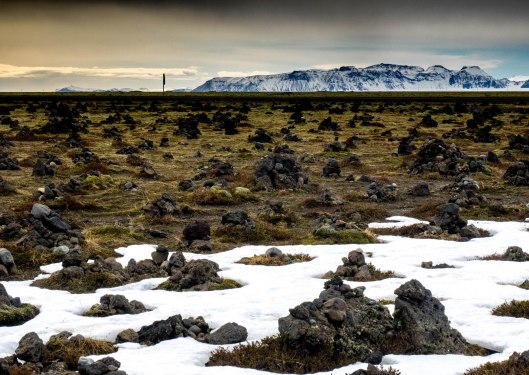
Eldraun lava field
The next stop was Kirkjubæjarklauster (you can imagine how much fun it was trying to type that into the semi-responsive screen of the sat-nav with frozen fingers) to look at another waterfall and to stop at another petrol station to buy another smoked lamb and three bean salad sandwich and to eat another chocolate bar which I would yet again discover halfway through had had liquorice slipped into it. Seriously people, liquorice is not a sweet. It is the byproduct of the manufacture of tractor tyres.

Stjornarfoss waterfall
Then, a long drive across the black, glacial-sand plain of Skeiðarársandur to Jökulsárlón. The landscape was still incredible enough to make stopping at every picnic area to take photographs an absolute requirement. At one point, after crossing what seemed to be a temporary metal bridge (which, given that my car had snow tyres with little spikes on, made a sound like an air-raid siren in a washing machine) I stopped at a wide lay-by with what I thought was an incongruous but nevertheless quite striking, modernist sculpture – two enormous steel beams twisted around one another. It turned out to the the remains of a road bridge destroyed by icebergs calved from the Skeiðará glacier which melted following the eruption of the volcano Grímsvötn in 1996. Seriously, I can see why they have kept the bridges temporary ever since.

The remains of the Skeidararsandur road bridge. In the background is the Skeidara glacier which destroyed it.
I arrived at Jökulsárlón about an hour before my ice cave tour was due to depart, which gave me ample time to walk up and down the lagoon and take photographs. Jökulsárlón is a glacial lake at the foot of the Breiðamerkurjökull glacier which, thanks to the glacier retreating, is growing in size year by year. The lagoon is famous for icebergs, which break off the glacier and float slowly towards the sea. It is the deepest lake in Iceland – as it would need to be given that 90% of each iceberg is submerged. There was one iceberg of notable size in the lagoon that day along with a few seals.

Jokulsarlon Ice Lagoon

Jokulsarlon Ice Lagoon
I arrived at the cafeteria – the muster point for the ice cave tour – in plenty of time. A bus full of East Asian tourists and a handful of Americans were also waiting. When the tour guide showed up I proffered my ticket to be told that I would be with a different company who were yet to arrive. I waited and waited but no sign. Fifteen minutes after the appointed departure time, I phoned the number on the ticket to be told that tour had been cancelled and that I should have received an email a month or so ago. Naturally, had this been the case, I said, I wouldn’t have been waiting in a freezing car park. It might be an idea that, for a trip that for which people cross continents, I added, to ensure that such emails were received, or to phone if no response were forthcoming. My words may have been a tad more earthy than that, but that was the gist anyway. By a stroke of incredible luck, the other tour had not yet left and they had space for one more, if I could pay in cash. By a further stroke of further luck, I could.
The delay, it turned out, was due to the fact that the caves that we were supposed to visit were a touch too melty (the reason the other company had cancelled) which would have involved squeezing through tiny, tiny gaps whilst waist-deep in freezing water. As I am intensely claustrophobic, this at least stopped tour groups from two different continents seeing me crying like a terrified child. Instead, we set off to see another cave.
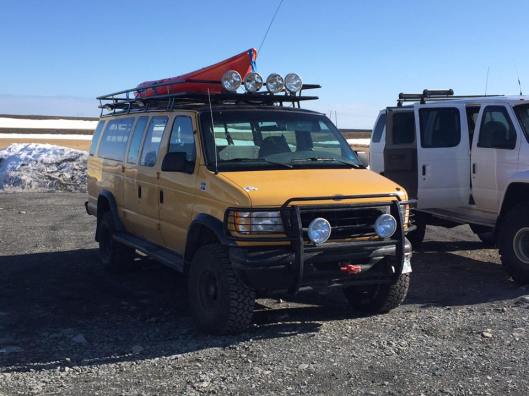
The ice cave tour bus
Ingmar, the tour guide was small but incredibly strong looking. Thankfully he also seemed incredibly cheerful. The drive to the starting point was across a ridiculously rocky field of moraine. As the huge-wheeled truck in which we rode jerked from side to side, up and down (at one point I could only see the ground through the windscreen) Ingmar, who was driving, had a cup of coffee. And he didn’t spill a drop. Such nonchalance may well have been calculated. But, hell, I was impressed.
After parking the truck, Ingmar proceeded to pass harnesses, carabiners, helmets and crampons out. I did not like the look of this. My only previous experiences of caves involved leisurely strolls through caverns with a guide using her torch to point out stalactites and stalagmites that looked humorously like elephants or penises or wheels of cheese (d0n’t ask – Derbyshire is a very strange place). It turned out we would have to undergo a “little” hike to get to the cave. I strapped on my harness and crampons and, grim-faced, set off. It turned out to be an incredible experience. Even though there was a narrow, handmade, wooden bridge across a chasm god only knew how deep and I am as scared of heights as I am of enclosed spaces. I was brave though, and hardly cried at all.
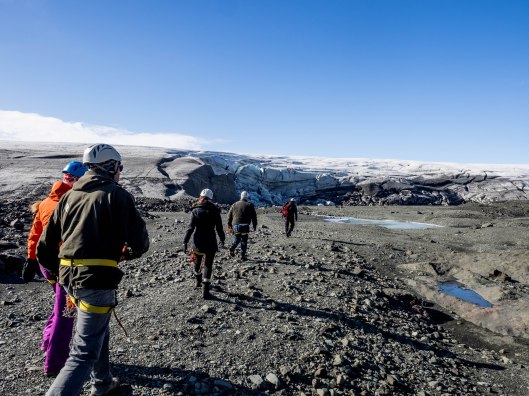
Hiking towards the glacier

The very scary bridge
The cave, when we reached it, was small but even more astonishing than expected. The light passing through the millions of tons of ice above turned the whole place an incredible, eerie blue. Ingmar pointed out that the stratified lines of grey we could see in the walls were volcanic ash from eruptions hundreds of years previously. A stream of water ran through the cave – water so pure, he said, that it would not quench your thirst as it lacked the minerals that the body craved. We stayed there longer perhaps than we should have, given that there were two more tour groups waiting outside. But hell, who cares?
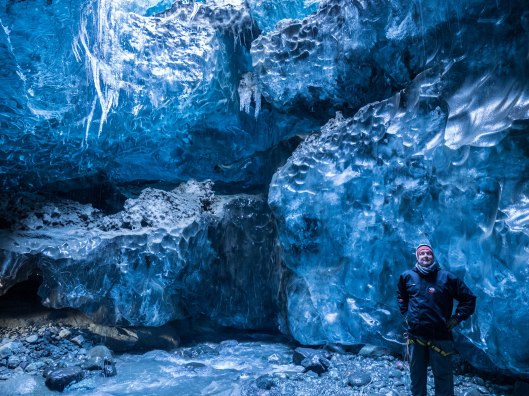
Inside the ice cave

Inside the ice cave
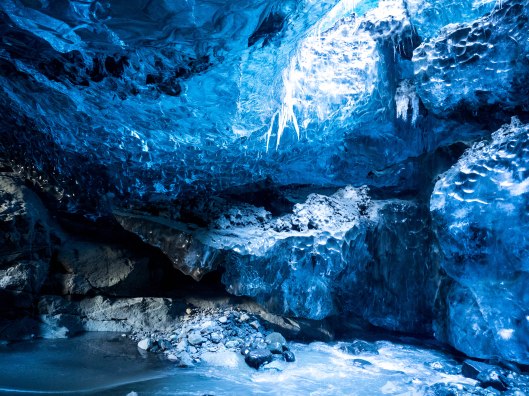
Inside the ice cave
As we re-crossed the scary bridge and scrambled across lumps of ice the size of small bungalows on our way back to the truck, we came across a lone, very grumpy looking tourist with an enormous backpack full of cameras and tripods. It seemed that the size and weight of his photographic equipment prohibited him from crossing the bridge and getting to the cave. In fear of missing the perfect shot, he failed to get any shots at all. I’m sure there’s a lesson in there somewhere, but I was too busy feeling smug about choosing the much-smaller-but-still-pro-quality mirrorless Olympus EM1 over a DSLR to figure it out.
We dismounted from the truck back at the Jökulsárlón cafeteria. Next came the Jökulsárlón ice beach – another black sand beach, but this time studded with stranded chunks of iceberg. Again, spectacular is not enough of a word, but it is the closest I can get.

Jokulsarlon ice beach

Jokulsarlon ice beach
By the time I had finished photographing the beach, it was 4.30pm. That night’s hostel was at least a 4 hour drive, so I set out hoping to make good time and get there before sundown. The weather, however, had different ideas. Bright and sunny, though still cold, with clear skies at first, the moment I rounded the outcrop that signalled the end of the Skeiðarársandur plain, clouds came down and snow started to fall. By the time I reached Vík, the snow was heavy and the road treacherous. I stopped at the now familiar Vík petrol station for what had become my usual Icelandic meal, and the weather worsened still. The twenty or so miles after leaving Vík were the most terrifying drive of my life. As the road wound up into the mountains, a full-on blizzard developed. Visibility was negligible and my speed was not much higher than walking pace. There was a pair of headlights behind me and I think without them, I may have gone crazy. It wasn’t like anything or anywhere I have ever experienced. And that was driving a VW Polo. I have nothing but the utmost respect for those crazy bastards who set out across Siberia or aim to conquer the North Pole on a dogsled or a pogo stick or whatever.
Eventually the snow lessened and the visibility improved and I was able to speed up a little. By the time I passed the Eyjafjallajökull volcano, I was making good time once again.
The hostel I had chosen that night was in a village called Gaulverjaskóli, deliberately chosen for its rurality (still hoping to see those damned elusive northern lights) and for being close to the Golden Circle, which was the bulk of the following day’s itinerary. Gaulverjaskóli is near the coast on a narrow, fertile strip of land between the Ölfusá River (Iceland’s largest river by volume) and the Þjórsá River (Iceland’s longest river). The drive along the banks of the Þjórsá was, again unsurprisingly, incredibly beautiful. The river was part-flowing, part-frozen with clusters of small icebergs jostling at the banks. The road itself was like something out of a rally stage – more potholes and mud than tarmac. And as I was in a rush to get to the hostel and as it was a rented car, it was great fun! All my Colin McRae fantasies played out against a backdrop of extreme natural beauty. There was not enough time (or light), sadly, for much photography, but I did manage to stop by one of many clusters of stocky Icelandic horses sheltering stoically against the wind and the cold and the occasional flurries of snow.
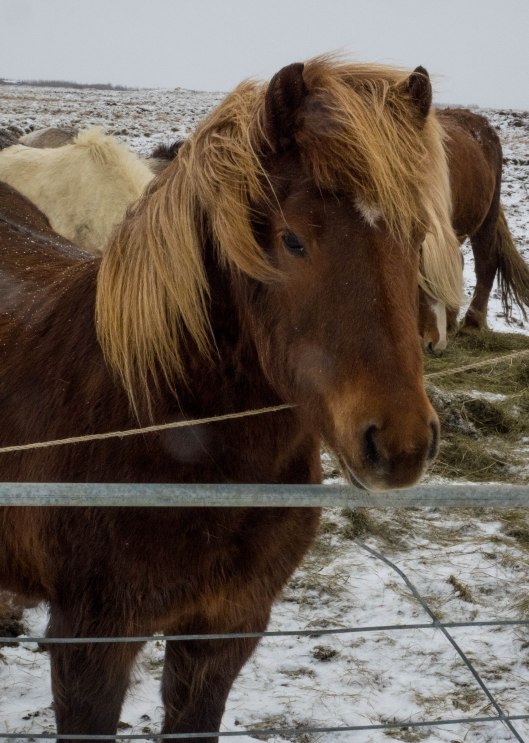
I reached the hostel just before dark, and it really was in the middle of nowhere. Even in a country where a village the size of Vík is an important settlement, this was something else. There was a school, a farm, a t-junction with a road sign and the hostel. The hostel itself was great – the woman who owned it lived with her family in an upstairs apartment. She was incredibly friendly, showed me around and then left me to it – shutting her apartment door behind her. Perfect. The only slight downside was that the walls were heavy and thick against the climate and thus the wifi was negligible. The only router was in the owner’s apartment. She had indeed mentioned that I might need to move around the middle part of the building to get a signal. As there was only one other guest, who had already gone to bed, I had the place to myself, so I managed to get the only spot where the wifi actually worked. I settled down to upload some pictures, disturbed only slightly when the owner’s son came out of their apartment and tripped over me squatting on their doormat.
Again, I slept with the curtains open hoping for some Aurora action. Again, I was stymied by clouds filled with snow. But the bed was comfortable, and I had a spare smoked lamb and three bean salad sandwich tucked away for breakfast so, once again, life was good. Very, very good.
The next day I set out to see the Golden Circle – Iceland’s much (and quite rightly so) lauded triple-whammy of the Geysir and Strokkur geysers, Gullfoss waterfall and Þingvellir (Anglicised as Thingvellir) national park, which, along with Reykjavík, will be the subject of my next blog post. See you there!

Once again incredible photos and prose.
LikeLike